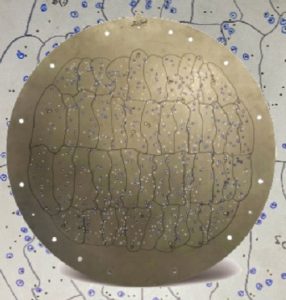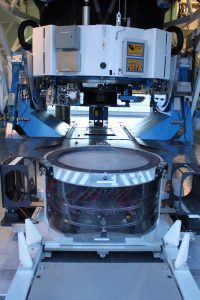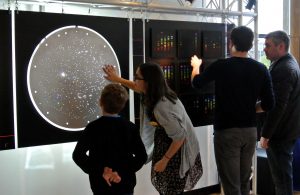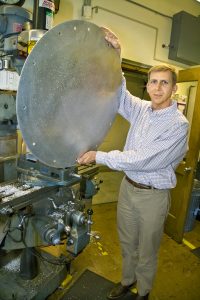
A plate from the SDSS-III BOSS survey, against a zoomed-in background of itself, showing the holes and the annotations used to help plug in the optical fibres. Credit: Sloan Digital Sky Survey.
They may not look like much — just metal disks 80 centimetres (30 inches) across with some etched markings and hundreds of small holes — but round aluminum “plates” like this one from the Sloan Digital Sky Survey (SDSS) have been vital to mapping our Universe for more than 20 years.
“The large number of objects in the sky that we have been able to observe using these plates has revolutionized many fields of astronomy, including the structure of our own Milky Way, the giant black holes at the centres of galaxies, and the evolution of the Universe as a whole,” says Dr. Jo Bovy. Bovy is an Associate at the Dunlap Institute for Astronomy and Astrophysics, and a Professor at the David A. Dunlap Department of Astronomy and Astrophysics, who has been involved with SDSS for over a decade.
The plates enabled the SDSS to use one of the most powerful techniques in astrophysics: splitting the light from an object up into the rainbow of its constituent colours to create a graph called a “spectrum,” which shows how much light of different energies the object emits.
Studying the spectrum of a galaxy can tell us details like how far away it is, how long ago its stars formed, and even how those stars orbit the supermassive black hole at the galaxy’s centre. The spectrum of the gas falling into that black hole can help us calculate how big the black hole is and how quickly it is growing. For an individual star, a spectrum can tell us its temperature, the chemical elements of which it is made, and how quickly it is moving towards or away from us. Multiple spectra of the same star over time can even be used to detect the presence of orbiting exoplanets or faint companions.
Astronomers have studied spectra of objects in the sky for centuries, but over time, a problem appeared. Traditionally, astronomers relied on tiny slits in metal sheets to pass the light from single — or at most, a few — stars or galaxies into one spectrograph (a device that measures a spectrum), often a laborious process. As sky surveys got bigger and needed to collect spectra for more and more stars and galaxies, it became impractical to wait for spectrographs to collect all the data using these traditional methods. A new approach was needed.

The final plate of the SDSS plate program sits at the base of the Sloan Telescope at the Apache Point Observatory in New Mexico, USA. The coloured fibres visible below the plate have been plugged into their holes and will carry the light to the waiting instruments. Credit: J. Burchett.
The solution came at the end of the 1990s, when astronomers and engineers from the SDSS began to drill hundreds of holes in large aluminum plates, each hole positioned to line up with a star or galaxy towards a particular patch of the sky as shown in this video of SDSS plates being drilled. When the plate was set at the back of the telescope, an optical fibre, carefully plugged by hand into each hole as shown in this video of observers plugging fibers into an SDSS plate, carried the light from the star or the galaxy into a spectrograph. This new system allowed several hundred spectra to be collected at the same time, dramatically increasing the speed at which objects in the sky could be measured.
In fact, SDSS-IV Director Mike Blanton explains that “the very first batch of data we used in early 2000 was almost as big as any of the previous redshift surveys ever done, and that was just from the first month or two of observations!”
Since those early measurements, more than twelve thousand plates have been drilled, hand-plugged, and observed. That’s a lot of metal — if all of these plates were piled together, their combined weight would equal that of 12 African bull elephants — or, for astronomers, a cube of white dwarf star material just under four centimetres (one and a half inches) on each side. All those plates would contain enough metal to make 4.3 million soda cans. All of these plates were drilled by engineers at the University of Washington’s machine shop, and each hole in each plate was plugged in by hand by staff at one of the SDSS’s telescopes in New Mexico and Chile.
The appearance of the plates has evolved over time, as the SDSS started new surveys, built new spectrographs, and even started using different telescopes. Many of the plates from recent years have more than one thousand holes each, or have holes for fibres from multiple spectrographs at the same time, or have holes that can accommodate bundles of dozens of optical fibres packed together. All told, more than 5.3 million individual holes have been drilled, each to within a tolerance of 10 micrometers (4 ten-thousandths of an inch). If you had to count all of these holes one-by-one, it would take you more than 60 straight days with no breaks.
What have we learned from the photons that passed through all those holes? “SDSS brought about the equivalent of an industrial revolution in astronomy – providing data for millions of stars, galaxies and quasars,” explains Dr. Ted Mackereth, Banting-Dunlap-CITA Fellow and member of the collaboration. “With data on these large scales, we are able to make truly statistical statements about how our Universe has formed and evolved. SDSS has provided deep insights on many scales in astrophysics, from planets to galaxies, to the large scale cosmic web of our Universe.” You can learn more about all the amazing results of the SDSS from our list of press releases.
One of the best parts of all this information is that it is available any time to anyone, anywhere. “All of the data obtained by SDSS are made public for every astronomer, and every person on the planet, to use,” says Bovy. “In fact, many of the most exciting discoveries using SDSS data have been made by people outside the collaboration, including members of the public as part of the Galaxy Zoo project.”

An art exhibit by SDSS Artist-in-Residence Tim Fitzpatrick in St Andrews, Scotland in 2015. Volunteers and visitors examine a backlit SDSS plate on the left and art inspired by astronomical spectra on the right. Credit: T. Fitzpatrick.
In addition to the vast scientific knowledge and online data troves enabled by this system, SDSS plates have provided a way for countless schoolchildren and members of the public to interact with real astronomical hardware and data. “To date, the SDSS’s Plates for Education program has distributed several hundred plates — all of which have been used to observe the sky — to schools, museums, and other educational institutions around the world,” explains Romina Ahumada, who leads these SDSS educational efforts in Chile.
The Plates for Education program has developed materials to help everyone learn about the celestial objects observed with the very plate in their hands, and to help educators incorporate the plates into their curricula to teach numerous astrophysical concepts. To learn how these curricula work, watch this online workshop given by SDSS astronomers Britt Lundgren and Gail Zasowski.

David Schlegel, a key developer of SDSS’s spectroscopy program and the Principal Investigator of the SDSS-III BOSS survey, holds up a newly drilled plate. Credit: Lawrence Berkeley National Laboratory.
Artists around the world have also explored numerous aspects of the plates as windows to the Universe, including Jian Yang in Beijing, Josiah McElheny in New York City (see also this preprint describing his work,) and SDSS’s own Artist-in-Residence Tim Fitzpatrick.
Now, after over two decades of using these plates to support its data collection (literally and metaphorically), the Sloan Digital Sky Survey is moving to a new era — one in which tiny robots will position each optical fibre to match the location of a star, galaxy, supermassive black hole, or other target. This is the perfect time to look back at the monumental scientific contribution of the plates, as the team plans for the next major developments that will be enabled by the new, even faster system.
“The plates have been amazing”, explains Juna Kollmeier, Director of the brand-new fifth phase of the SDSS project (SDSS-V), as well as the brand-new Director of CITA (Canadian Institute for Theoretical Astrophysics) at the University of Toronto.
Although observations with the SDSS plates have now ended, the survey looks ahead to an even brighter future. SDSS-V observations have already begun, using a sophisticated system in which robots repeatedly arrange and rearrange the optical fibres, allowing far more objects to be observed in far shorter times.
Kollmeier continues, “With SDSS-V and its robots, we will now be able to fully probe the entire sky with spectra, repeatedly in time, and make that data available to the world. How does the Universe change over days, weeks, or even years?”
“We’ve had key snapshots of the Universe — now it’s time to make the movie.”
___________________________________________________________________________________________
Press contacts:
Michael Blanton, michael.blanton@nyu.edu
Juna Kollmeier, jak@cita.utoronto.ca
Gail Zasowski, gail.zasowski@gmail.com
To speak to Jo Bovy or Ted Mackereth, contact:
Meaghan MacSween
Communications and Multimedia Officer
Dunlap Institute for Astronomy & Astrophysics,
University of Toronto
meaghan.macsween@utoronto.ca
The Dunlap Institute for Astronomy & Astrophysics at the University of Toronto is an endowed research institute with more than 90 faculty, postdocs, students and staff, dedicated to innovative technology, ground-breaking research, world-class training, and public engagement. The research themes of its faculty and Dunlap Fellows span the Universe and include: optical, infrared and radio instrumentation; Dark Energy; large-scale structure; the Cosmic Microwave Background; the interstellar medium; galaxy evolution; cosmic magnetism; and time-domain science. The Dunlap Institute for Astronomy and Astrophysics, David A. Department of Astronomy & Astrophysics and the Canadian Institute for Theoretical Astrophysics comprise the leading centre for astronomical research in Canada, at the leading research university in the country, the University of Toronto.</em
